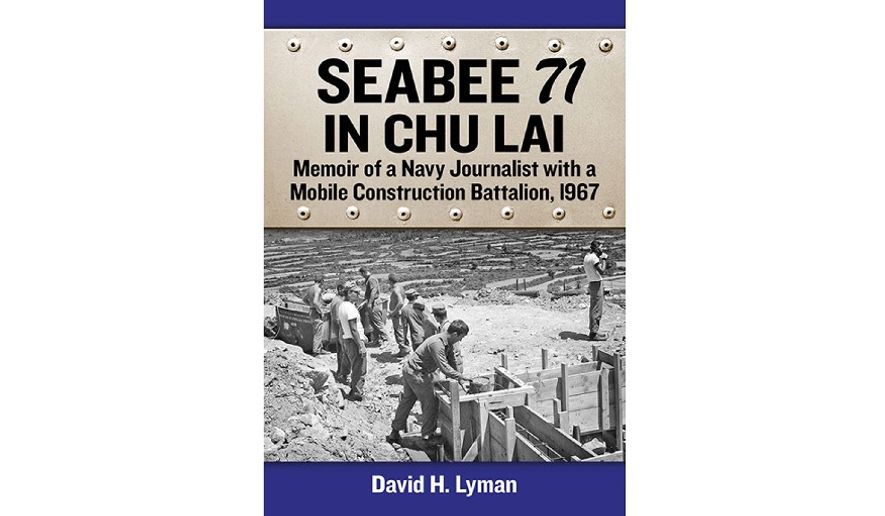OPINION:
David H. Lyman, like a good number of potential draftees in the 1960s, joined the military reserves in a desire to stay out of Vietnam during the war. Ironically, he ended up in Vietnam as a member of the Seabees (construction battalion) in 1967.
“I joined the Naval Reserve in 1963, primarily to avoid the draft and stay out of a foxhole in Vietnam,” Mr. Lyman writes in the preface of his slim memoir. “With my background and education in journalism, I wound up a JO3 Journalist Third Class. In 1966 I was commandeered off a Navy ship because a newly forming Seabee outfit, Mobile Construction Battalion 71, needed a journalist. I was not a real Seabee, I was a ‘fleet-bee,’ one of the office guys from the fleet.”
He said it was his job to publicize the battalion’s actions and accomplishments by writing press releases for the service members’ families back in the states and by writing stories and taking photographs that appeared in the battalion’s monthly newspaper, The Transit, which he edited.
“I was more PR hack than journalist,” Mr. Lyman notes.
In his book, “Seabee 71 in Chu Lai: A Navy Journalist’s Memoir of His 14 Months with MCB 71, 1966-67,” Mr. Lyman recounts his time serving with the Seabees in Chu Lai, where the Seabees built roads, airfield runways, buildings and other projects.
Mr. Lyman describes the battalion’s combat training given by Marines who served in Vietnam, as Seabees are trained and required to fight to protect themselves if attacked. After shipping out to Chu Lai in South Vietnam, the then-27-year-old sailor and the other men of the battalion lived in plywood huts called “hooches” with basic (some would call it primitive) facilities in a camp set up along the beach and the South China Sea.
“A Seabee outfit, or Naval Mobile Construction Battalion, is sort of like MASH (Mobile Army Surgical Hospital) unit, as seen in the popular movie and TV series. It is a self-contained unit of around 800 men and officers with its own cooks, office personnel, chaplain, engineers, architects, construction workers, doctors, and a monthly newspaper,” explains the author.
“As a mobile unit we can “bug out” at any time, move halfway around the world, set up camp, and build anything the military wants — an entire Naval base if necessary, although that might require two battalions.”
Formed in World War II, the Seabees built roads, runways, barracks and other structures needed by the military. The work of the Navy’s Seabees was dramatized in the 1944 John Wayne movie, “The Fighting Seabees.” The Seabees were also dramatized in John Wayne’s 1968 Vietnam War film, “The Green Berets.”
The ratio of supporting troops to rifle-toting soldiers in the bush was about 10-to-one during the Vietnam War. As a photojournalist, David Lyman was in a support position, and he acknowledges that he saw little direct combat. Their camp was hit routinely with Viet Cong mortars and rockets, and there were land mines on the roads and the occasional Viet Cong sniper.
When a Marine squad was missing in action while sailing down the Tra Bong River on a Vietnamese sampan, the Marines went to the Seabees and asked if the battalion’s Underwater Construction Team divers could sweep the river and look for the lost Marines. The Marines wanted their men back, dead or alive.
The author accompanied the divers, Marines and U.S. Army soldiers aboard a Marine AmTrac (Amphibious Tractor, Personnel), which floated down the river. The AmTrac had tank tracks and could operate on land as well as the water.
With the divers in the water, a sniper opened fire on the floating AmTrac. A Marine fired back with his M60. The author managed to draw his .45 from the holster, place a round in the chamber and fire in the general direction as the others.
“The only sound now was the popping of my pistol … and laughter. The men on my AmTrac busted a gut over the journalist and his total unprofessional gunnery,” Mr. Lyman recalls. ‘Hey, journalist!’ one of them shouted, ‘shoot pictures. We’ll do the real shooting!’”
The author also describes his travels to Japan to print the monthly newspaper, as well as his travels to Da Nang, Saigon and other places as he covered stories and took photographs of the Seabees at work.
Along with his stories, the book also features Mr. Lyman’s photos that originally appeared in The Transit.
“Seabee 71 in Chu Lai” is an interesting account of the Seabees in Vietnam.
• Paul Davis served on an aircraft carrier during the Vietnam War, and as a part-time Navy journalist he wrote news and feature articles for the ship’s newspaper.
• • •
SEABEE 71 IN CHU LAI: A NAVY JOURNALIST’S MEMOIR OF HIS 14 MONTHS WITH MCB 71, 1966-97
By David H. Lyman
McFarland, $35, 225 pages




Please read our comment policy before commenting.